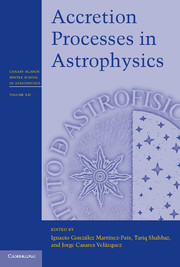Book contents
- Frontmatter
- Contents
- List of contributors
- List of participants
- Preface
- Acknowledgments
- Abbreviaions
- 1 Accretion disks
- 2 The evolution of binary systems
- 3 Accretion onto white dwarfs
- 4 Multiwavelength observations of accretion in low-mass X-ray binary systems
- 5 X-ray binary populations in galaxies
- 6 Observational characteristics of accretion onto black holes I
- 7 Observational characteristics of accretion onto black holes II: environment and feedback
- 8 Computing black-hole accretion
- A Piazzi Smyth, the Cape of Good Hope, Tenerife, and the siting of large telescopes
- References
7 - Observational characteristics of accretion onto black holes II: environment and feedback
Published online by Cambridge University Press: 05 January 2014
- Frontmatter
- Contents
- List of contributors
- List of participants
- Preface
- Acknowledgments
- Abbreviaions
- 1 Accretion disks
- 2 The evolution of binary systems
- 3 Accretion onto white dwarfs
- 4 Multiwavelength observations of accretion in low-mass X-ray binary systems
- 5 X-ray binary populations in galaxies
- 6 Observational characteristics of accretion onto black holes I
- 7 Observational characteristics of accretion onto black holes II: environment and feedback
- 8 Computing black-hole accretion
- A Piazzi Smyth, the Cape of Good Hope, Tenerife, and the siting of large telescopes
- References
Summary
7.1 Introduction
I'll begin this chapter with one of my favorite quotes about black holes:
Of all the conceptions of the human mind, from unicorns to gargoyles to the hydrogen bomb, the most fantastic, perhaps, is the black hole; a hole in space with a definite edge into which anything can fall and out of which nothing can escape; a hole with a gravitational force so strong that even light is caught and held in its grip; a hole that curves space and warps time. Like unicorns and gargoyles, black holes seem more at home in the realms of science fiction and ancient myth than in the real Universe. Nonetheless, well-tested laws of physics predict firmly that black holes exist.
(Thorne, 1994)… and add that not only do the laws of physics predict that black holes exist, but a vast array of observational evidence points to their existence in a range of masses and environments, throughout the universe. Whether or not they really exist is debated by some and is hard to prove to the satisfaction of others, but there are clearly a vast number of objects (> 1016) in the observable universe that conform very closely to our concept of a black hole (i.e., high accretion efficiency but otherwise “dark,” no apparent surface, simple scaling of properties over a range ≥ 108 in mass). In this contribution to the XXI Canary Islands Winter School of Astrophysics, I focus on these objects, specifically on the observational consequences of accretion onto them, and the associated feedback to the surrounding environment.
- Type
- Chapter
- Information
- Accretion Processes in Astrophysics , pp. 227 - 252Publisher: Cambridge University PressPrint publication year: 2014



